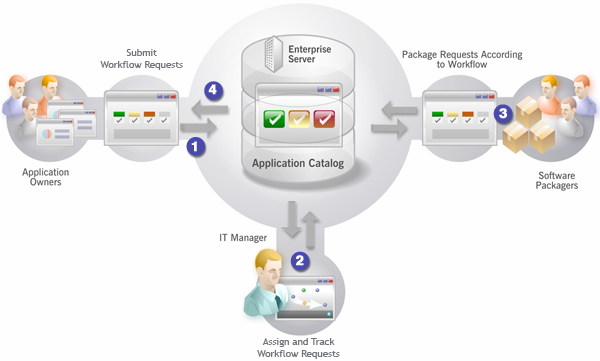
Workflow Manager 6.5
You can use Workflow Manager to monitor and control the software packaging, deployment, and management process across your enterprise. Workflow Manager enables your IT department to follow a single efficient process when preparing applications for deployment.
The following diagram illustrates how you can use Workflow Manager to connect IT management, software packagers, and application owners to streamline the packaging process:

Workflow Manager and the Application Lifecycle
Workflow Manager gives application owners an easy way to submit workflow requests to IT Management, who can then approve and assign the request to the most available software packager. Software packagers receiving a request see at a glance each process step and the tasks that they need to complete. As they complete their tasks, Workflow Manager automatically routes the request on to the next process step, improving efficiency while ensuring steps are never overlooked.
This diagram is described in the following table:
|
# |
Step |
Description |
|
1 |
End User Submits a Workflow Request |
An end user, defined as a consumer in the Workflow Manager system, could be a person in your accounting department who wants a copy of Excel installed, or a System Administrator at one of your client companies who wants a copy of Photoshop repackaged and ready for distribution. When submitting a request, the user is prompted to enter data required by the specified workflow template that was used to create this request. |
|
2 |
IT Manager Reviews Request and Assigns Tasks |
The IT Manager, defined as a workflow administrator in the Workflow Manager system, reviews the request to see if all required information has been entered. He then assigns the request to individual accounts or to a role. |
|
3 |
Packagers Repackage Application and Perform Testing |
Software packagers at the administrator company perform the tasks detailed on the workflow. As they perform each step, the appropriate personnel at both the consumer and administrator company are informed. |
|
4 |
End User is Notified that Application is Ready for Installation |
When all phases of the workflow have been completed, the person who originally submitted the request is informed that his application is ready for his use. |
Using Workflow Manager to manage your application life cycles provides the following benefits:
| • | Enables consumer self-service through a web-based interface. |
| • | Monitors progress through the migration life cycle and provides real-time status reporting. |
| • | Tracks all steps involved in application lifecycle via workflows. |
| • | Creates a centralized repository of critical package metadata. |
| • | Keeps an audit trail of critical consumer and packager communications, both internal and external. |
| • | Enforces packaging standards and processes. |
Workflow Manager 6.5 / AdminStudio Enterprise Server 11.5 Help LibraryDecember 21, 2012 |
Copyright Information | Contact Us |